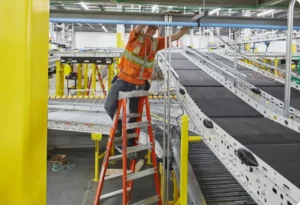In industrial automation and material handling, the term “photo eye” refers to a photoelectric sensor that uses light to detect the presence or absence of objects, often along conveyor lines. These sensors are crucial components in automated systems because they can signal controllers when a part passes a certain point, trigger motion, halt flow, or coordinate sorting logic.
Banner Engineering describes photoelectric sensors (photo eyes) as devices that emit a beam of light and detect when that beam is interrupted or reflected by an object. When the beam is disturbed, the receiver registers a change and the system responds with an output, turning conveyors on/off, indexing, counting, or rerouting items.
How Photo Eyes Work
A typical photo eye setup includes a light emitter and a receiver:
- The emitter sends out a beam of light (infrared, polarized, or visible).
- When an object passes through or reflects that beam, the receiver senses the change.
- That change triggers the sensor’s output to the control system (PLC, motor drive, etc.).
Depending on the application and sensor style, photo eyes can detect objects that are shiny, dark, clear, or of varied colors.
Photo eyes are widely used in material handling, packaging, food & beverage, and industrial manufacturing to monitor conveyors, count items, detect jams, and more.
Common Types of Photo Eyes
Different styles of photo eyes are used depending on the layout, spacing, and environment. Here are the main types:
Through-Beam (Opposed) Sensors
- The emitter and receiver face each other in a line-of-sight setup.
- When anything breaks the light path, the sensor triggers.
- Very accurate and robust for long distances.
Retroreflective Sensors
- The emitter and receiver are in the same housing.
- A reflector is placed opposite them.
- The beam returns via the reflector; interrupting it causes activation.
Diffuse or Proximity (Reflective) Sensors
- The emitter emits light that reflects off the target itself.
- Doesn’t require a separate reflector.
- Works well for short distances, but reflection properties of the target matter.
Each type has advantages. For example, through-beam sensors handle dirty environments better because there’s no sensing surface near the beam path. Diffuse sensors are simpler to mount but are more sensitive to the reflective surface of the object.
Benefits & Considerations of Using Photo Eyes
Benefits
- Non-contact detection. No mechanical wear or physical interference.
- Fast reaction times. Ideal for high-speed systems.
- Versatility. Can detect many materials, shapes, and colors.
- Integration. Works well with PLCs, conveyors, and control systems.
Challenges & Design Considerations
- Alignment sensitivity: Some sensor types (especially through-beam) require precise alignment.
- Reflectivity/Surface effects: Glossy or transparent parts may confuse certain sensors (especially diffuse types).
- Ambient light interference: Strong lighting or sunlight can impact performance if the sensor isn’t tuned or shielded properly.
- Dirty environments: Dust, debris, or build-up can block or degrade the beam path. Choose more robust sensor types where necessary.
At Prairie Electric, when we build automated conveyor systems, all the logic and controls that drive sorting, indexing, and product flow often rely on photo eyes. We program their output into PLCs and integrate them into control panels that we assemble in-house, all built to UL-listed standards.
Contact us today to explore how we can make your conveyor smarter, more responsive, and more efficient. We serve industrial clients nationwide while continuing to provide the best electrical service in Vancouver, WA.


